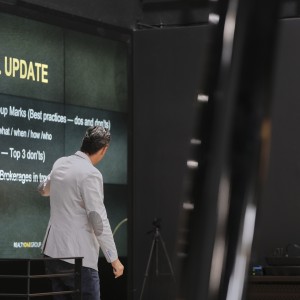
There’s one thing for certain. The current COVID-19 pandemic has changed our lives irrevocably. For most of us, that will simply mean we are going to place so much more value on things we previously took for granted, like a handshake, an embrace, or simply the ability to gather in a group with the ones we love.
For property agents in general, and the transaction itself, I believe this period will be forever viewed as a wake-up call. There are a lot of Realtors® that have been caught out not changing and evolving in their property marketing. Instead simply doing the same thing from one listing to the next because it is easy and there is a mentality of “why fix it if it ain’t broke”. Services that were already existing in plain sight have suddenly become main-stays or must-have items in brokerages across America when in the past they were viewed as “optional extras”.
360° Virtual Real Estate Tours are a classic example of this. There are defined and clear statistics, pointing to the fact that an immersive tour is of benefit to a purchaser (NAR 2019 Generational trends). And now as agents furiously search for tools to assist virtual inspections and open houses the words ‘I told you so’ are of benefit to no one.
Rather than a post-mortem, let’s look at shooting in 360° and three important aspects to consider regarding 360°/Virtual Tour platforms.
I’d like to encourage you to begin to think about virtual tours more in the way you would about standard photography. The application is effectively the same and the process looks something like this:
- Preparing the home for the shoot
- Selecting your hardware for the shoot
- Capturing the home
- Editing the images
- Uploading to your portal
Where a Virtual Real Estate Tour becomes harder is the pathway forward. Most Realtors® do not know where to begin in order to move forward. Hopefully this conversation will help you with that.
Hardware.
Whilst it sounds like we are going to Home Depot to pick-up the latest and greatest drill, really all the term ‘hardware’ refers to is the physical device we are going to use to capture 360° images (the camera). Today there are at least 30 devices that you can choose from to capture 360° images. They range from attachments for your smartphone (like the Insta 360 nano S approx $139), to small handheld 360 cameras, all the way up to a Kandao Obsidian or a Matterport Pro 2 (approx. $3395) An added complexity is that some cameras just won’t work on some platforms, so before you make a knee-jerk reaction purchase, you might want to check the camera works with the platform.
The Hardware or camera BoxBrownie.com recommends is the Ricoh Theta V. It ranges in price from between $370-380 new (Amazon). We recommend it simply because it is the best of the lower priced cameras, very portable, excellent quality and lastly because it has a function called bracketing, which will allow the user to upgrade your image quality should you ever wish to take advantage of editing services.
You will also need a monopod. A monopod is a single-legged stand for your camera. Monopods are essential because they have the lowest foot-print of any stand, and rarely get in the way of the shot. I recommend one that is eye height, fairly portable and has a solid base. The Neewer is a solid monopod with a good mix of all of those three things.
Software
To operate most 360° cameras, there will be software to download in order to both use and view the 360° images. Each camera will have an application available on the smart phone of your choice. That app, will operate the functions and change the settings of the camera both when shooting and when sending the images elsewhere. Other free software exists for you to view 360° images on the computer itself, including my two favorites Go Pro, Ricoh.
These are good for viewing single 360° globes, but they will not aid you in creating a virtual tour. That will need to be done via a hosting platform.
If you are wanting to edit your 360° images you will find BoxBrownie.com’s Image Enhancement and Virtual Staging services, perfect for improving image quality or adding furniture to a vacant space.
Hosting Platforms
There are so many of these in today’s marketplace it can be hard to pick between them. I would begin with social media platforms, both Facebook and YouTube will accept 360* degree files. Both these channels are great for quickly getting an immersive experience to the market. YouTube is a great place to upload a 360° video of you walking through the home you are wanting to display and 360° images get more engagement than digital still images on facebook.
Beyond the free channels exist virtual tour providers. You can upload any of the images you have created to portals like Ricoh Tours, Matterport and BoxBrownie.com to be placed and displayed into a tour. There are variations with each of these providers and considerations need to be given to the following: Cost of subscription, time taken to capture a tour, specific branded hardware required for the platform, time taken to upload a tour, overall image quality and purchaser experience. If you are looking for a subscription-based service you might want to check out Matterport and Ricoh Tours offerings. If you are after a pay as you go service, then at BoxBrownie.com we can help you with that.
Click here to walk through a virtual tour
BoxBrownie.com is a 24/7 photo and virtual tour editing company providing a range of services for real estate marketing, offering a no subscription, pay as you go service, with edits returned within 24 hours. They truly are a real estate sales professionals secret weapon for property marketing! As a Realty ONE Group real estate professional when you sign up for your FREE TRIAL you’ll receive complimentary credits for three image enhancements, ONE day to dusk edit and ONE virtual staging. Get started today with UNbelievably quality at lighting speed.


